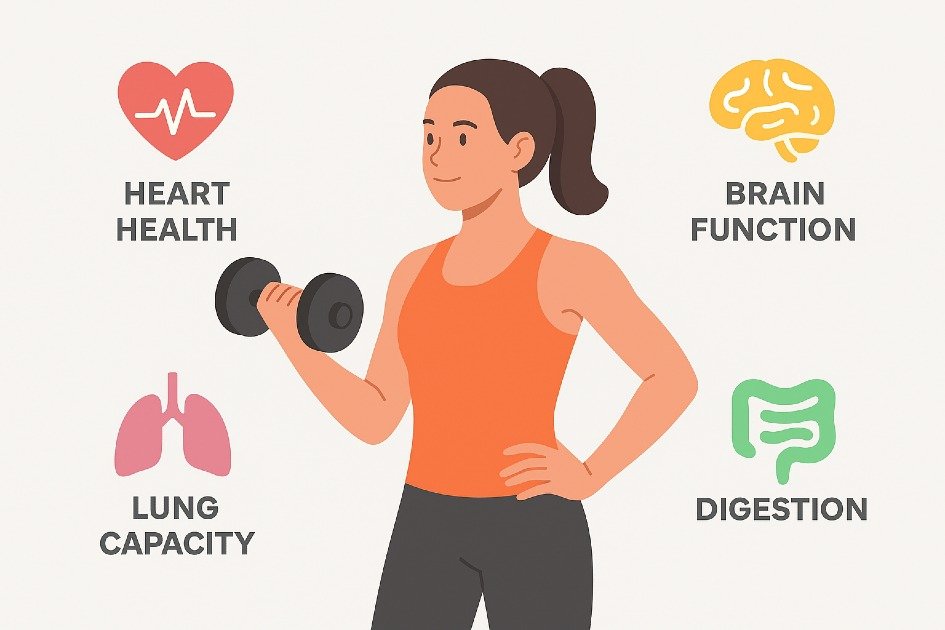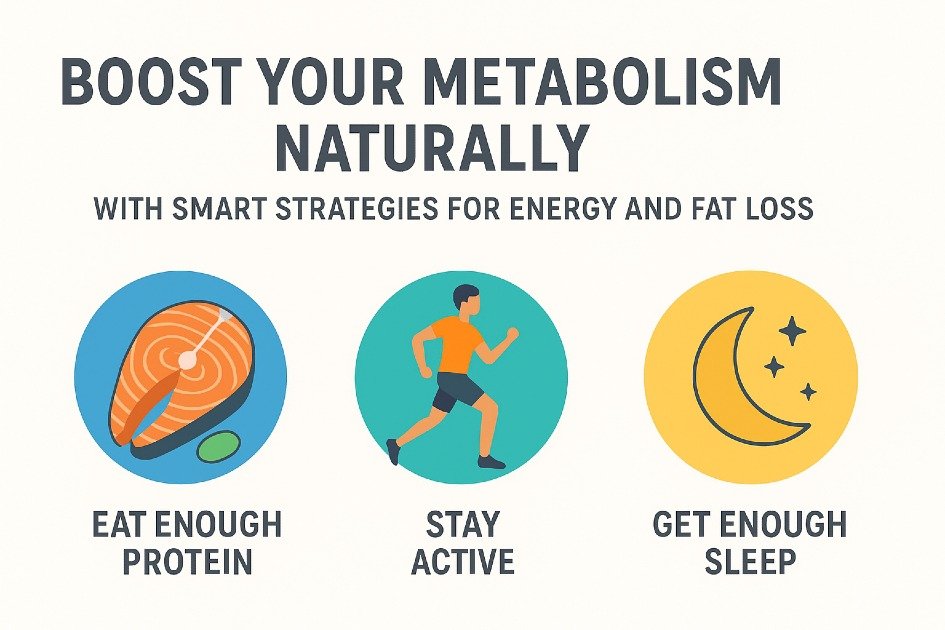Strength training is a powerful approach to weight loss that not only burns calories during workouts but also transforms metabolism, preserves lean muscle, and keeps weight off long after sweat dries.
Harvard Health suggests resistance training aids weight loss by burning calories during and after workouts, while weight training helps preserve muscle mass.
It builds muscle that works around the clock, allowing the body to burn more calories even while resting.
Even simple routines with dumbbells, resistance bands, or bodyweight exercises can spark significant changes.
Strength training also sharpens posture, increases energy, reduces weight creeping back, strengthens bones, stabilizes joints, and protects long-term mobility.
Strength training is essential for sustainable weight loss and can transform fitness journeys by building a strong, lean, and energized body, making it a crucial addition to fitness routines.

Why Strength Training is More Than Just Lifting Weights
Strength training is a lifestyle tool that transforms body appearance, function, and functions, transforming health and confidence. Despite being viewed as exclusive to athletes, its full benefits are significant.
Breaking the Myth: Strength Training vs. Cardio
Cardio is often viewed as the “gold standard” for weight loss, but its short-term results can lead to slow metabolism and weight reintroduction.
Strength training builds lean muscle, burning calories even when not exercising, unlike cardio, which rents results.
Blend cardio with strength training, such as 20 minutes of weightlifting and 15 minutes on the bike, to burn fat and prevent future weight gain.
When I switched from cardio to weight training, I noticed substantial changes. I lost weight, felt more energy, and grew stronger for daily tasks. Lifting weights gave me results I never saw with just cardio.
How Muscle Changes the Way Your Body Burns Calories
Muscles are essential for maintaining energy levels, while fat is storage. Focusing on diet and exercise can lead to muscle loss, slowing metabolism and causing weight to regain.
Strength training, like lifting, squatting, or pushing resistance, builds muscle that supports weight loss, resulting in the afterburn effect, allowing metabolism to stay elevated for hours post-exercise.
Start with bodyweight exercises like squats, push-ups, or planks if weights seem intimidating, gradually move to dumbbells or resistance bands for lasting results.
When I started strength training, I noticed my clothes fit better even though the scale did not move right away. Building muscle helped me burn more calories, lose fat, and improve how my body looked and felt.

The Science Behind Strength Training and Fat Loss
Strength training offers sustainable fat loss, a key benefit of cardio, making it a practical and achievable option for those starting their fitness journey.
Muscle as Your Body’s Natural Fat-Burning Engine
Weight loss often struggles when plateaus are reached due to muscle loss from diets and excessive cardio, slowing metabolism and making it harder to burn fat.
Strength training enhances metabolism, converting muscle tissue into a 24/7 calorie-burning system, enhancing energy consumption even when sitting on the couch.
I noticed real changes in my body after lifting weights just three times a week. My muscles felt stronger, and my frame looked more toned. I started small with budget-friendly dumbbells and resistance bands, and they worked better than I expected.
The Afterburn Effect: Burning Calories Even at Rest
Cardiovascular exercise burns calories while moving, but its effect ends when exercise is stopped, leading to feelings of overtraining and burnout.
Strength training triggers Excess Post-Exercise Oxygen Consumption (EPOC), a process that continues to repair muscles and restore energy after the workout, maintaining a high metabolism even during rest or sleep.
One of my clients saw substantial changes after moving from treadmill runs to strength training. She felt more energized, her clothes fit better, and she spent less time working out while getting better results.

Boosting Your Metabolism the Smart Way
Strength training can significantly enhance metabolism, making it a powerful fat-burning engine, despite its often-elusive nature in weight loss.
Why Strength Training Supercharges Your Calorie Burn
Why it matters:
Muscle tissue requires more energy than fat and carrying more lean muscle increases calorie burn at rest, reducing stubborn fat and promoting long-term weight loss.
How to do it:
- Do compound moves like squats, deadlifts, and push-ups. They work many muscles at the same time, helping you build strength faster.
- Do strength training 2–4 times a week. Staying consistent matters more than going hard in the beginning.
- Track progress by noting the weight you lift, the reps you complete, or how strong you feel in daily tasks.
I noticed that even a little progress in strength training made a significant difference. Within just a few weeks, my metabolism felt faster, and I had more energy every day.
Burning Calories Long After Your Workout
Why it matters:
EPOC, or Excess Post-Exercise Oxygen Consumption, is a technique where the body continues to burn calories even after leaving the gym, unlike cardio.
How to do it:
- To enhance strength routines, incorporate high-intensity intervals like super setting exercises, which involve performing two exercises back-to-back with minimal rest.
- Lift slightly heavier weights over time keeps your metabolism active longer.
- Adequate protein intake can expedite muscle repair and enhance the afterburn effect when combined with adequate protein intake.
Eating to Fuel Your Metabolism Smartly
Why it matters:
Nutrition prevents metabolism slowdown during strict diets, while strength training increases nutrient needs for muscle repair, hindering fat loss if not properly incorporated.
How to do it:
- Incorporate lean protein sources such as chicken, fish, tofu, or eggs into each meal.
- Choose high-quality protein powders for a quick and easy option.
- To maintain stable energy levels and prevent metabolic dips, evenly space meals throughout the day.
- Avoid skipping breakfast as it signals your metabolism to begin working efficiently.
Small Lifestyle Tweaks That Keep Your Metabolism Active
Why it matters:
Daily habits, including workouts, significantly impact metabolic rate, and even minor changes can lead to meaningful results, while sedentary patterns can slow progress.
How to do it:
- Take brief walking breaks every hour, even a 5-minute one.
- Use a stability ball or stand instead of sitting at a desk all day.
- Consuming sufficient water is crucial for metabolic processes.
- Guided relaxation or meditation can effectively reduce stress and prevent hormonal shifts that can slow metabolism.
Rest and Recovery: The Secret Metabolic Booster
Why it matters:
Muscles repair and grow during rest, boosting metabolic efficiency. Overtraining can suppress metabolism and increase injury risk.
How to do it:
- Take 1–2 full rest days each week to let your body recover and grow stronger.
- Get 7–9 hours of quality sleep nightly. Lack of sleep slows your body’s fat-burning power.
- Use light stretching or mobility exercises on rest days to boost circulation and speed muscle recovery.
Combining Strength Training with Smart Cardio
Why it matters:
Cardio alone can temporarily burn calories but does not boost resting metabolic rate; strength training, combined, maximizing total calorie expenditure and metabolic boost.
How to do it:
- Alternate strength and cardio days to prevent burnout.
- Use short bursts of high-intensity cardio after strength workouts to capitalize on EPOC.
- Consider activities you enjoy—cycling, brisk walking, or swimming—to make the routine sustainable.
I boost my metabolism with strength training by pairing smart workouts, good nutrition, healthy habits, and proper rest. This helps my body burn more calories naturally, even when I am not exercising.

Building Lean Muscle for a Toned Look
Strength training involves shaping your body, increasing metabolism, and achieving a toned, strong physique by building lean muscle, transforming body composition, and efficiently burning fat.
Enhance Lean Muscle Gains
Why it matters:
Lean muscle enhances resting metabolic rate, body symmetry, and functional strength, reduces injury risk, and boosts confidence, promoting a more energized and capable lifestyle.
How to do it:
- Compound exercises—like squats, deadlifts, push-ups, and pull-ups—work several muscles at once. Begin with light weights and slowly increase resistance to stay safe.
- Progressive overload means slowly lifting heavier weights, doing more reps, or working harder over time. This helps muscles grow and keeps your workouts improving when you track them.
- Use a mix of free weights, resistance bands, and bodyweight exercises to keep muscles challenged. Do circuits with 3–4 moves that work all major muscle groups.
- Focus on proper form to prevent injuries. Use mirrors or record yourself to check technique, and work with a trainer to learn the basics.
- Eat protein from chicken, fish, eggs, or plants. Add healthy fats and complex carbs for lasting energy. Use quality protein supplements to support muscle growth.
- Muscles grow while you rest, not while you train. Give each muscle group 48 hours to recover and add stretching or yoga to stay flexible.
I take the stairs instead of elevators, squeeze in quick strength moves during breaks, track my progress, and celebrate every win to keep my legs strong and toned.

Strength Training Improves Hormonal Balance
Strength training not only enhances body shape but also reprograms hormones, promoting fat loss, energy, and a vibrant appearance, thus optimizing body fat storage, muscle building, and appetite regulation.
Reduce Fat-Storing Hormones
Why this matters:
Chronic stress triggers cortisol levels, causing the body to store fat, drain energy, increase sugar cravings, and slow workout recovery.
How to do it with strength training:
- Do compound moves like squats, deadlifts, and push-ups. They work many muscles at once and help lower post-workout stress.
- Lift moderately: Heavy weights when stressed or tired can raise cortisol. Stick to moderate intensity for better results.
- After your workout, do deep breathing or stretches to relax your body and calm your mind.
I found that just 20 minutes of steady strength training helps lower my stress hormones and speeds up recovery.
Boost Fat-Burning Hormones
Why this matters:
Strength training naturally elevates testosterone and growth hormone levels, enhancing fat-burning efficiency and preventing frustration in fat loss despite diet adherence.
How to do it with strength training:
- Lift heavy weights for major exercises, doing 5–8 reps per set, to naturally boost testosterone.
- Do explosive moves like kettlebell swings or jump squats to naturally boost growth hormone.
- Rest 1–3 minutes between sets to boost gains and keep your hormones strong.
I can boost these hormones using just my bodyweight or resistance bands, so I see progress no matter my level.
Balance Appetite-Regulating Hormones
Why this matters:
Strength training helps stabilize hormones leptin and ghrelin, which can lead to overeating and weight gain, enabling better control of cravings and adherence to a nutrition plan.
How to do it with strength training:
- Exercise 3–5 times a week to keep your hormones balanced and strong.
- Eat protein after workouts to boost muscle repair and support leptin.
- Combine strength exercises with quick cardio bursts to better control your appetite.
After a month of regular strength training, I feel full longer and crave fewer sweets.
Improve Insulin Sensitivity
Why this matters:
Strength training enhances insulin sensitivity, preventing fat accumulation and energy crashes. It helps the body use carbs for energy instead of storing them as fat.
How to do it with strength training:
- Do full-body workouts 2–3 times a week to work more muscles and improve blood sugar control.
- Increase weights or reps gradually to challenge muscles and boost insulin health.
- Pair exercise with lean proteins, fiber-rich carbs, and healthy fats to boost insulin health.
I lift weights to stay healthy—strength training helps my body use insulin better, burn fat, build muscle, control my appetite, and keep my energy high.

Increased Strength Leads to More Active Living
Strengthening muscles enhances daily activities, mobility, and overall well-being, promoting physical activity, improved body sensation, and increased enjoyment of life.
Why Stronger Muscles Make Everyday Life Easier
Why this matters:
Daily activities can be reduced due to improved posture and balance, reducing the risk of injuries from overexertion.
How to do it:
- Squats, push-ups, and lunges work key muscles to build real-life strength.
- Resistance bands are portable and ideal for strengthening muscles used in daily movements.
- Compound lifts like deadlifts and bench presses train many muscles at once, building strength you use every day.
Boosting Endurance for Active Living
Why this matters:
Reduces physical exertion, promotes outdoor and recreational activities, and supports long-term mobility as you age.
How to do it:
- Do many reps with light weights to build endurance, like 15–20 squats or shoulder presses.
- Do circuit training: switch between strength moves and quick cardio bursts to boost real-life fitness.
- Slowly raise your workout time and effort to strengthen muscles safely.
Improving Balance and Coordination
Why this matters:
Increased daily mobility, improved athletic performance in recreational sports, and increased confidence in any environment are all benefits of this approach.
How to do it:
- Strengthen your balance by doing single-leg moves like one-leg deadlifts or step-ups.
- Do core exercises like planks, Russian twists, and stability ball moves to strengthen your abdominal muscles and improve balance.
- Train your body to react to real-life movements using balance boards and other proprioception tools.
Encouraging More Active Hobbies and Lifestyle Choices
Why this matters:
This promotes consistent calorie burn outside structured workouts, enhances physical and mental well-being, and reduces sedentary habits that lead to weight gain.
How to do it:
- Plan fun activities weekly like hikes or swim sessions.
- Take part in group sports or fitness classes to stay active and make exercise fun.
- Track your progress to see how building strength boosts your stamina for the activities you love.
Strength Training for Daily Energy Boosts
Why this matters:
Reduced mid-day fatigue and lethargy, improved productivity at work or home, and enhanced mood and motivation for activity are some benefits.
How to do it:
- Do a quick 10-minute resistance band workout in the morning to build strength daily.
- Combine strength moves with mobility drills to boost blood flow and improve joint flexibility.
- Keep challenging your muscles by slowly adding more weight or resistance.
I use a resistance band set that works for beginners and pros alike. I also rely on adjustable dumbbells to build real strength.

Strength Training Protects Your Weight Loss Results
Strength training is a game-changer for weight loss, helping to prevent the “yo-yo effect” and ensure consistent results after strict dieting.
Maintain Lean Muscle to Keep Calories Burning
Why it matters:
Losing weight often results in the loss of both fat and muscle, which are metabolically active and help slow metabolism, making it easier to regain weight.
How to do it:
- Do compound moves like squats, deadlifts, push-ups, and rows. They work many muscles at once and burn more calories.
- Workout 2–4 times weekly. Stay consistent—short, focused sessions build muscle and burn fat.
- Slowly lift heavier weights or add resistance to keep your muscles growing and your metabolism active.
- Muscles repair and get stronger during recovery. Wait at least 48 hours before your next hard workout.
I keep my metabolism strong by staying lean, so my weight loss lasts longer.
Prevent Weight Regain by Strengthening Your Core
Why it matters:
A strong core stabilizes posture, improves movement efficiency, reduces injury risk, and maintains weight, making it crucial for daily activities and workouts.
How to do it:
- Planks and variations: Hold for 20–30 seconds, then slowly increase time as you get stronger.
- Anti-rotation exercises: Use cables or bands to strengthen your core against twisting movements.
- Functional moves: Do lunges with a twist or use a medicine ball to rotate, copying real-life movements.
I strengthen my core to move with confidence and burn calories naturally every day.
Combat the Plateau Effect with Muscle Preservation
Why it matters:
Dieters often plateau due to muscle loss from calorie restriction, while strength training helps preserve muscle and efficiently burn fat.
How to do it:
- Measure progress by strength, not just the scale. Aim to lift a little more each week.
- Vary your workouts by lifting heavy with few reps one day, then go lighter with more reps another day to challenge your muscles.
- Work all major muscles each session to burn more energy for full-body workouts.
I keep my muscles strong, so I push past weight loss plateaus without starving myself.
Improve Hormonal Balance to Sustain Weight Loss
Why it matters:
Muscle-building exercises help reduce fat-storing hormones like cortisol and insulin, while boosting growth hormone and testosterone, thereby aiding in weight loss.
How to do it:
- Do strength circuits: Combine key moves with short rests to boost hormones.
- Strength training boosts key hormones better than long cardio sessions by lifting weights.
- Steady, moderate workouts keep hormones balanced and help control weight long-term.
When I balance my hormones with strength training, my body burns fat more easily—even on tough days.
Build Confidence and Motivation to Stay Consistent
Why it matters:
Weight loss is a mental and physical process, driven by tangible strength gains that encourage regular exercise and healthier choices.
How to do it:
- Take progress photos or body measurements. They show real changes the scale cannot.
- Celebrate progress by adding just five pounds to your lift.
- Switch up your workouts with kettlebells or resistance bands to keep fitness fun and engaging.
I gain confidence from consistent strength training, and it makes maintaining my weight feel like a rewarding habit, not a daily struggle.
Transitioning to Lifestyle Longevity
Why it matters:
Strength training not only aids in weight management but also builds lifelong health, resilience, and energy by protecting muscles and metabolism through every meal, movement, and workout.
How to do it:
- Do full-body workouts 2–3 times a week to build strength, burn calories, and stay balanced.
- Choose steady growth, not shortcuts.
In my own journey, I have seen that small, steady steps keep my results stronger than any extreme diet ever could.
Recap: Embrace Strength Training Your Key to Lasting Fat Loss
Strength training is a lifestyle choice that not only enhances physical fitness but also mental health.
Harvard Health emphasizes that regular exercise enhances mood, sleep, heart health, reduces disease risk, and improves physical and mental well-being.
It does not only burn calories after workouts but also improves hormonal balance, allowing for better control of appetite and stress.
Whether you are a beginner or seasoned athlete, strength training empowers you to conquer everyday tasks with confidence and enhances functional fitness.
The sense of accomplishment after completing a challenge reinforces motivation and resilience, helping you achieve fitness goals.
Consistent strength training can transform your body and mind, and by sharing your journey and exploring tools, you can experience compounding benefits for years to come.
Frequently Asked Questions
Do I need heavy weights to see results with strength training?
Strength training can be fat-burning without massive dumbbells. Progressive overload, using moderate dumbbells, resistance bands, or bodyweight exercises, can lead to excellent results with 10-20 minutes of daily sessions.
How quickly will I notice fat loss from strength training?
Tracking lean mass is a more accurate method for monitoring success than relying solely on weight, as subtle body composition changes can be noticeable within 4-6 weeks.
Can I replace cardio completely with strength training for weight loss?
Strength training enhances muscle building and metabolic rate, while aerobic activity boosts cardiovascular health. A hybrid approach, combining strength and light cardio, yields sustainable fat-loss results.
What is the best balance between strength training and diet?
Strength training alone does not replace poor diet; a balanced nutrition plan with protein intake is crucial for optimal fat loss, enhancing muscle repair and growth.
Is strength training safe for beginners or older adults?
Strength training is safe and effective for all ages, with proper form, starting with lighter weights and gradually increasing resistance. Functional exercises improve mobility, bone density, and joint stability.
Can I start strength training without a gym?
Home-based strength training programs are convenient, cost-effective, and flexible, requiring minimal equipment like dumbbells, resistance bands, or household items.
How many days per week should I perform strength training for weight loss?
Beginners should aim for 2-3 weekly sessions, intermediates 4-5 sessions, maintaining consistency and recovery time, and avoiding overtraining to ensure progress.
Will strength training make me bulky?
Strength training boosts lean muscle mass, metabolism, and sculpts the body without bulkiness, especially for women with lower testosterone levels, resulting in a toned, powerful silhouette.
How does strength training affect metabolism?
Regular strength training boosts basal metabolic rate, enabling effective fat loss over time, resulting in an “afterburn” effect called EPOC, which continues to burn calories post-exercise.
Can strength training help prevent weight regain?
Strength training aids in maintaining and increasing lean muscle mass, which often declines during dieting, thereby ensuring elevated metabolism and reducing rebound weight gain.

